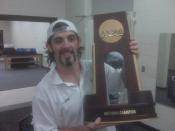February 28, 2009AbstractTitle IX has made a significant impact by attacking gender discrimination in sports. Although the original legislation was passed in 1972, implementation was delayed due to problems in interpretations. The ÃÂThree-Prong-TestÃÂ of Title IX has directly resulted in an increase of women participation in sports. Even though Title IX has been put to the test by multiple different legal arguments, Title IX and its ÃÂThree-Prong-TestÃÂ has prevailed once all the facts were presented.
Since its first introduction in 1979, the ÃÂthree-prong-testÃÂ of Title IX has been highly controversial. Many anti-Title IX groups contend that it is often interpreted as a quota, placing too much emphasis on the first prongÃÂs reference to proportionality, and failing to take into account the gendersÃÂ differing levels of interest in athletics. Others feel that the interpretation of Title IX actually discriminates against men by removing opportunities of male athletes and giving them to females who are less interested.
Supporters of the ÃÂthree-prong-test of Title IX defend that gendersÃÂ that differ athletic interest is merely a product of past discrimination, and that Title IX should be interpreted to maximize participation of female athletes regardless of any existing disparity of interest. So, is the ÃÂthree-prong-testÃÂ an appropriate tool to show compliance of Title IX? I believe after uncovering the history of Title IX, defining what each of the prongs are and dissolving some of the misconstrued facts regarding Title IX and itÃÂs ÃÂthree-prong-testÃÂ, that the majority of Americans would be in favor of Title IX and itÃÂs compliance tools.
Title IX refers to an Education Amendment provision of 1972 that states: ÃÂNo person in the United States shall, on the basis of sex, be excluded from participation in, be denied the benefits of, or be subjected to discrimination under any education program or activity receiving Federal financial assistance.ÃÂ (http://www.aauw.org/advocacy/laf/lafnetwork/library/athleticshistory.cfm?renderforpri) Nowhere in the Title IX law does it mention ÃÂsportsÃÂ or anything about athletics. It was intended to cover all programs receiving federal funding assistance. This includes science and math classes as well as any non-sport extracurricular activities such as school bands and recreational clubs. However, the area of athletics draws the most concern and controversy making Title IX and its three-prong-test most visible.
In 1979 the Department of Education (under President CarterÃÂs administration) established a ÃÂthree-prong-testÃÂ to insure compliance with the highly controversy Title IX law. The test provides that an institution is in compliance with Title IX if (1) the number of athletic participants should mirror the number of undergraduate students from a participation percentage standpoint (Appenzeller and Appenzeller page 251). For example a college in Mississippi where women make up 65 percent of the undergraduate student body and the men make up the remaining 35 percent; then the 65 percent of the athletes should be women and 35 percent males. There should be enough sports to accommodate the percentage difference. If an institution fails to meet the first prong of proportionality standard, then the second (2) prong states ÃÂschools may demonstrate that they have regularly added teams in an effort to increase opportunities for the underrepresented genderÃÂ(Appenzeller and Appenzeller page 251). If the institution fails to meet both prong one and two, there is still yet another opportunity for compliance known as the third prong (3) which states ÃÂSchools may demonstrate that when members of the underrepresented gender have demonstrated sufficient ability and interest to warrant the addition of a new program and/or new participation opportunities, that interest has been met (Appenzeller and Appenzeller page 251). If an institution is suspected to be in non-compliance or a complaint is filled against the institution, the Office of Civil Rights (OCR) can and may conduct an audit. There are possibly 13 other components that can be evaluated within the athletic area, if an audit is warranted. The two that are most likely to draw the most attention and controversy are: sport offerings which is the one we hear about the most and the second is scholarships. The other 11 areas are usually program specific areas that include things like equipment, scheduling, travel, tutorial services, coaching, facilities, competitors, medical, practice and training facilities, support services and recruitment (www.ed.gov/about/offices/list/ocr/docs/t9interp.html).
After Title IX became law, the National Collegiate Athletic Association (NCAA), which had governed only menÃÂs intercollegiate athletics since 1906, started expressing their concern. The NCAA felt that the movement for equity would undermine and dissolve menÃÂs intercollegiate sport; therefore, it adamantly began challenging the legislation. At first, the NCAA tried through legislative and judicial systems to remove athletics from Title IX, but that yielded negative results. Next, it began a large campaign to support the Tower Amendment, which sought to exclude revenue-producing sport athletics from Title IX, but that amendment quickly died. Finally, the association focused on the scope of Title IXÃÂs jurisdiction. The NCAA challenged whether Title IX extended to any and all programs offered by an educational institution that received funds, the ÃÂinstitutionalÃÂ approach, or whether it only included specific programs that received funds directly, the ÃÂprogrammaticÃÂ approach. Under the programmatic approach, the athletic programs would not be required to comply with Title IX, whereas under the institutional approach, programs would fall within the scope of Title IX. This became important to the NCAA due to most schools that received federal funds did not apply it directly to athletics. However, the association would lose this approach when the Javits Amendment was passed by Congress, which did not exempt revenue producing sport from Title IXÃÂs scope.
A last ditch effort by the NCAA was to take control of women programs; thereby limiting the effect those programs would have on men athletics. This forced the disbandment of the Association of Intercollegiate Athletics for Women (AIAW), which was founded in 1971 as an advocate for womenÃÂs sport. The AIAW officially disbanded in June 1982.
Women would continue to experience setbacks when the U.S. Supreme Court rendered a decision on the issue of ÃÂinstitutionalÃÂ or ÃÂprogrammaticÃÂ approaches in Grove City College v. Bell (465 U.S. 55 [1984]). The court ruled that only programs receiving direct funding fell under the scope of Title IX. Hardly any athletic programs received direct finical aid from the federal government. However, Congress then enacted, over presidential veto, the Civil Rights Restoration Act of 1988, which redefined the terms ÃÂprogram or activityÃÂ to mean ÃÂany part of college, university, or post secondary institution, which is extended Federal financial assistanceÃÂ(Duncan, page 367).
The Supreme Court, ironically, provided a stronger impact for womenÃÂs quest for equality in sport with their ruling on February 26, 1992, in Franklin v. Gwinnett County Public Schools (503 U.S. 60). The Supreme CourtÃÂs unanimous decision allows students to sue for sexual harassment, damages and other types of sexual discrimination. This ruling provided an enormous push for equity in schools and colleges because athletic programs are required to comply with Title IX. If they fail to comply, the institution can face great economic loss if sued. On April 22, 1997, the Supreme Court let stand a lower court ruling that schools must ensure the proportion of female athletes mirrors the proportion of women in the student body. This ruling forced educational institutions to expedite toward full compliance.
Mrs. Welch Suggs in her book ÃÂA Place on the Team: The Triumph and Tragedy of Title IXÃÂ provides an excellent in depth defining of each prong. In her explanation she states the first option institutions had to show compliance was prong one. ÃÂAre participation Opportunities Substantially Proportionate to Enrollment? Where an institution provides intercollegiate level athletic participation opportunities for male and female students in numbers substantial proportionate to their respective full-time undergraduate enrollments, OCR will find that the institution is providing nondiscriminatory participation opportunities for individuals of both sexesÃÂ (Suggs, page 232). This interpretation refers to participants as being athletes: ÃÂWho are receiving the institutionally-sponsored support normally provided to athletes competing at the institution involvedÃÂ (Suggs, page 232). For example, health care and exercise rooms, coaching instruction and equipment usage on a regular scheduled basis during a specific sportÃÂs season, or those who participate in structured training sessions and other team gatherings and functions on a regular basis during the season; and who are listed on the eligibility or squad lists maintained for each sport, and those because of injury, cannot meet either of the conditions above, but continue to receive financial aid due to their athletic ability. The OCR then determines whether athletic opportunities are substantially proportionate by examining whether participation opportunities are ÃÂsubstantiallyÃÂ proportionate to enrollment rates. Suggs also explains that ÃÂbecause this determination may vary depending on the institutionÃÂs specific circumstances and size of its athletic department, OCR makes this determination on a case-by-case basis, instead of relying on statistical dataÃÂ (Suggs, page 233). Even if an institutions enrollment percentages are satisfied per prong one, the OCR understands that yearly changes can and do happen in an institutionÃÂs enrollment and participation rates may vary from school year to school year. For example, if the institutionÃÂs student admissions for the next year showed a decrease in either male or female participation rates, the institution would still be in compliance with prong one because it would be unrealistic to expect the college or institution to re-vamp its programs based on a sudden change. However, the institution should take it into consideration the following year.
Suggs also further explains prong two by stating: ÃÂIs there a history and continuing practice of program expansion for the underrepresented Sex? An institution can show that it has a recorded and continuing practice of program expansion which is demonstrably responsive to the developing interests and abilities of the underrepresented sexÃÂ (Suggs, page 233). OCR may review the entire history of an athletic program, focusing on the participation opportunities provided for the underrepresented sex. According to Suggs the first thing OCR will evaluate is ÃÂwhether past actions of the institution have expanded participation opportunities for the underrepresented sex in a style that has demonstrably responsive to their developing interests and abilities. There are no set time intervals which an institution must have added participation opportunities. Nor are a particular number of sports required. But, the focus will be on whether the program expansion was responsive to developing interests and abilities of the underrepresented sexÃÂ (Suggs page 233). Further more, the institution must demonstrate a continuing practice of program expansion as warranted by developing interest and abilities. Some of the factors OCR will take into consideration are: ÃÂan institutionÃÂs record of adding intercollegiate teams, or upgrading teams to intercollegiate status, for the underrepresented sex; the record of increasing the numbers of participants in intercollegiate athletics who are members of the underrepresented sex; and an institutionÃÂs affirmative response to request by students or others for addition or elevation of sportsÃÂ (Suggs, page 234). If an institution removes any team associated with the underrepresented sex, the OCR would investigate the circumstances surrounding this action in assessing whether the institution could satisfy part two of the test. However, the OCR may not discover a ÃÂhistory and continuing practice of program expansion where an institution increases the proportional participation opportunities for the underrepresented sex by reducing opportunities for the overrepresented sex alone or by reducing participation opportunities for the overrepresented sex to a proportionately greater degree than for the underrepresented sexÃÂ (Suggs, page 234). And finally, the OCR will not find that an institution is in compliance with part two if its ÃÂestablished teams for the underrepresented sex only at the initiation of its program for the underrepresented sex or where it merely promises to expand its program for the underrepresented sex at some time in the futureÃÂ (Suggs, page 235).
Suggs also further defines Part Three of the prong by stating ÃÂIs the institution fully and effectively accommodating the interests and abilities of the underrepresented sex? Under this prong the OCR can determine whether an institution is fully and effectively accommodating the interest and abilities of its students who are members of the underrepresented sex-including students who are admitted to the institution though not yet enrolledÃÂ (Suggs, page 235). Title IX provides that a recipient must provide equal athletic opportunity to its students. However, the Policy Interpretation does not require an institution to meet the interest and abilities of potential students. ÃÂWhile disproportionately high athletic participation rates by an institutionÃÂs students of the overrepresented sex may indicate that an institution is not providing equal athletic opportunities to its students of the underrepresented sex, an institution can satisfy this prong by showing evidence that the imbalance does not reflect discrimination, example, where it can be demonstrated that notwithstanding disproportionately low participation rates by the institutionÃÂs students of the underrepresented sex, the interests and abilities of these students are in fact being fully and effectively accommodatedÃÂ (Suggs, page 235). In making this determination, the OCR will consider the three following factors: ÃÂ(1) unmet interest in a particular sport; (2) sufficient ability to sustain a team in the sport; and (3) a reasonable expectation of competition for the associated teamsÃÂ (Suggs page 235). If all three conditions are met, OCR will find that an institution is not in compliance and can not fully and effectively accommodated the interests and abilities of the underrepresented sex. If an institution suddenly removed a viable team from the intercollegiate program, ÃÂ the OCR can find that there is sufficient interest, ability, and available competition to sustain an intercollegiate team in that sport unless an institution can provide strong evidence that interest, ability, or available competition no longer existsÃÂ (Suggs, page 235). The OCR will also look at other local participation rates in sports in high schools, amateur athletic associations, and community sports leagues that operate in areas from which the institution draws its students in order to determine likely interest and ability of its students and admitted students in particular sport. For example, where OCRÃÂs investigation finds that a particular sport which the institution does not offer for the underrepresented sex, OCR will ask the institution to provide a basis for any assertion that its students and admitted students are not interested in playing that sport. OCR may also interview admitted students, enrolled students, coaches and others regarding interest in the sport (Suggs, page 235).
Here are some of the most common myths regarding Title IX and the three-prong-test:MYTH ÃÂ Title IX was created solely for fairness in athletics.
FACT ÃÂ Although Title IX is associated mostly with athletic programs, it is not just a law that pertains to sports. The law applies to all educational programs offered by and institution that receives federal funds.
MYTH ÃÂ Girls and women are less interested in sports than boys and men.
FACT ÃÂ This is a gender-based stereotype that perpetuates discrimination and will not hold up in court. If athletic opportunities are available, females will become involved. This is evident by the consistent increase of female athletes in high schools since 1972 (http://www.ncwge.org/).
MYTH - Schools must offer the same number of menÃÂs and womenÃÂs teams.
FACT ÃÂ Equal participation opportunities most be afforded to both genders. Schools do not have to offer the same number of teams or a specific sport. (www.womenssportsfoundation.org).
MYTH ÃÂ Athletic opportunities for men have decreased due to Title IX.
FACT ÃÂ Participation rates have increased for both women and men at both the college and high school levels (http://www.ncwge.org/).
MYTH ÃÂ Institutions must cut menÃÂs athletic teams to comply with Title IX.
FACT ÃÂ Title IX does not require a equal number of female and men sport teams, but rather both have equal opportunities to participate in athletic activities (http://www.ncwge.org/).
Before the passage of Title IX, women composed only 7 percent of the total number of athletic participants in high school and 16 percent in college. By 1992, 37 percent of all interscholastic participants and 35 percent of all NCAA intercollegiate participants consisted of women. In a report released in 2000 by the NCAA, the 1998 academic year had 145,832 female athletes competing at NCAA member schools; which are 41 percent of all collegiate athletes, and the number of female participants in intercollegiate athletics grew to 58 percent during the 1990s. The Melpomene Institute and the Miller Lite Report both concluded that women who were active in sports at a young age feel greater confidence and self-esteem in their physical and social selves than women who didnÃÂt participate in sports as youths. The WomenÃÂs Sports Foundation notes that women who participate in sports are more likely to experience academic success than women who do not participate in sports. Also, women who participate in sports are more likely to do well in science courses. The NCAA has listed higher graduation rates for women athletes than for women students alone.
The enforcement of Title IX by its three-prong-test has yielded significant results by insuring not just women receive equal opportunity in athletics, but men also. The debates will always continue on whether the test is appropriate or not. However, when one takes a minute to evaluate the history and extraordinary results Title IX has produced for women athletes, I believe they will see that Title IX is not just a quote system for women. The three-prong-test is simply a tool used to insure fairness. Each prong providing a different avenue with different options to best suit an institutions particular needs.
Suggs, W. (2005). A Place On The Team. Princeton, New Jersey: Princeton University Press (2005).
Appenzeller, H. and Appenzeller T. (2008). Successful Sport Management 3rd Edition. Durham, North Carolina: Carolina Academic Press (2008).
Sawyer T. and Smith, O. (1999). The Management of Clubs, Recreation and Sport Concepts and Aplications. Champaign, Illinois: Sagamore Publishing (1999).
Duncan, J. (2004). From Ali to X-Games: Sport in American Culture. Santa Barbara, California: Santa Barbara Press (2004).
Blumenthal, K. (2005). Let Me Play. New York, New York: Simon & Schuster (2005).
AAUW. (2005). Title IX. In A Brief History. Retrieved May 1, 2005, from http://www.aauw.org/advocacy/laf/lafnetwork/library/athleticshistory.cfm?renderOffice of Civil Rights (OCR). (March 14, 2005). U.S. Department of Education. In A Policy Interpretation: Title IX and Intercollegiate Athletics. Retrieved February 5, 2009, from http://www.ed.gov/about/offices/list/ocr/docs/t9interp.html.
National Coalition for Women and Girls in Education (NCWGE). (January 13, 2009). National Coalition for Women and Girls in Education (NCWGE). In Title IX. Retrieved February 5, 2009, from http://www.ncwge.org/#.
Woman's Sports Foundation. (January 12, 2008). Title IX. In Policy Update. Retrieved February 5, 2009, from http://www.womenssportsfoundation.org/Issues-And-Research/Title-IX/Policy-Update.aspx.





